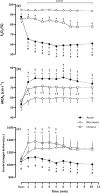AltitudeOmics: exercise-induced supraspinal fatigue is attenuated in healthy humans after acclimatization to high altitude
- PMID: 24450855
- PMCID: PMC4291113
- DOI: 10.1111/apha.12241
AltitudeOmics: exercise-induced supraspinal fatigue is attenuated in healthy humans after acclimatization to high altitude
Abstract
Aims: We asked whether acclimatization to chronic hypoxia (CH) attenuates the level of supraspinal fatigue that is observed after locomotor exercise in acute hypoxia (AH).
Methods: Seven recreationally active participants performed identical bouts of constant-load cycling (131 ± 39 W, 10.1 ± 1.4 min) on three occasions: (i) in normoxia (N, PI O2 , 147.1 mmHg); (ii) in AH (FI O2 , 0.105; PI O2 , 73.8 mmHg); and (iii) after 14 days in CH (5260 m; PI O2 , 75.7 mmHg). Throughout trials, prefrontal-cortex tissue oxygenation and middle cerebral artery blood velocity (MCAV) were assessed using near-infrared-spectroscopy and transcranial Doppler sonography. Pre- and post-exercise twitch responses to femoral nerve stimulation and transcranial magnetic stimulation were obtained to assess neuromuscular and corticospinal function.
Results: In AH, prefrontal oxygenation declined at rest (Δ7 ± 5%) and end-exercise (Δ26 ± 13%) (P < 0.01); the degree of deoxygenation in AH was greater than N and CH (P < 0.05). The cerebral O2 delivery index (MCAV × Ca O2 ) was 19 ± 14% lower during the final minute of exercise in AH compared to N (P = 0.013) and 20 ± 12% lower compared to CH (P = 0.040). Maximum voluntary and potentiated twitch force were decreased below baseline after exercise in AH and CH, but not N. Cortical voluntary activation decreased below baseline after exercise in AH (Δ11%, P = 0.014), but not CH (Δ6%, P = 0.174) or N (Δ4%, P = 0.298). A twofold greater increase in motor-evoked potential amplitude was evident after exercise in CH compared to AH and N.
Conclusion: These data indicate that exacerbated supraspinal fatigue after exercise in AH is attenuated after 14 days of acclimatization to altitude. The reduced development of supraspinal fatigue in CH may have been attributable to increased corticospinal excitability, consequent to an increased cerebral O2 delivery.
Keywords: adaptation; altitude; exercise; transcranial magnetic stimulation.
© 2014 Scandinavian Physiological Society. Published by John Wiley & Sons Ltd.
Figures





Similar articles
-
AltitudeOmics: on the consequences of high-altitude acclimatization for the development of fatigue during locomotor exercise in humans.J Appl Physiol (1985). 2013 Sep 1;115(5):634-42. doi: 10.1152/japplphysiol.00606.2013. Epub 2013 Jun 27. J Appl Physiol (1985). 2013. PMID: 23813531 Free PMC article.
-
UBC-Nepal expedition: acclimatization to high-altitude increases spinal motoneurone excitability during fatigue in humans.J Physiol. 2018 Aug;596(15):3327-3339. doi: 10.1113/JP274872. Epub 2017 Dec 18. J Physiol. 2018. PMID: 29130497 Free PMC article.
-
Supraspinal fatigue after normoxic and hypoxic exercise in humans.J Physiol. 2012 Jun 1;590(11):2767-82. doi: 10.1113/jphysiol.2012.228890. Epub 2012 Apr 2. J Physiol. 2012. PMID: 22473785 Free PMC article. Clinical Trial.
-
Neuromuscular fatigability at high altitude: Lowlanders with acute and chronic exposure, and native highlanders.Acta Physiol (Oxf). 2022 Apr;234(4):e13788. doi: 10.1111/apha.13788. Epub 2022 Jan 25. Acta Physiol (Oxf). 2022. PMID: 35007386 Free PMC article. Review.
-
Fatigue and Exhaustion in Hypoxia: The Role of Cerebral Oxygenation.High Alt Med Biol. 2016 Jun;17(2):72-84. doi: 10.1089/ham.2016.0034. High Alt Med Biol. 2016. PMID: 27281471 Review.
Cited by
-
Post-fatigue ability to activate muscle is compromised across a wide range of torques during acute hypoxic exposure.Eur J Neurosci. 2022 Sep;56(5):4653-4668. doi: 10.1111/ejn.15773. Epub 2022 Jul 22. Eur J Neurosci. 2022. PMID: 35841186 Free PMC article.
-
The Exercising Brain: An Overlooked Factor Limiting the Tolerance to Physical Exertion in Major Cardiorespiratory Diseases?Front Hum Neurosci. 2022 Jan 21;15:789053. doi: 10.3389/fnhum.2021.789053. eCollection 2021. Front Hum Neurosci. 2022. PMID: 35126072 Free PMC article. Review.
-
Reply from Luca Ruggiero, Alexandra F. Yacyshyn, Jane Nettleton and Chris J. McNeil.J Physiol. 2018 Aug;596(15):3427. doi: 10.1113/JP275978. Epub 2018 Mar 30. J Physiol. 2018. PMID: 29484649 Free PMC article. No abstract available.
-
The acclimatised spinal cord.J Physiol. 2018 Aug;596(15):2949-2950. doi: 10.1113/JP275552. Epub 2017 Dec 27. J Physiol. 2018. PMID: 29215739 Free PMC article. No abstract available.
-
AltitudeOmics: Red Blood Cell Metabolic Adaptation to High Altitude Hypoxia.J Proteome Res. 2016 Oct 7;15(10):3883-3895. doi: 10.1021/acs.jproteome.6b00733. Epub 2016 Sep 27. J Proteome Res. 2016. PMID: 27646145 Free PMC article.
References
-
- Ainslie PN, Ogoh S. Regulation of cerebral blood flow during chronic hypoxia: a matter of balance. Exp Physiol. 2009;95:251–262. - PubMed
-
- Amann M, Calbet JA. Convective oxygen transport and fatigue. J Appl Physiol. 2008;104:861–70. - PubMed
-
- Amann M, Romer LM, Pegelow DF, Jacques AJ, Hess CJ, Dempsey JA. Effects of arterial oxygen content on peripheral locomotor muscle fatigue. J Appl Physiol. 2006b;101:119–127. - PubMed
Publication types
MeSH terms
Substances
Grants and funding
LinkOut - more resources
Full Text Sources
Other Literature Sources
Medical
Research Materials
Miscellaneous

